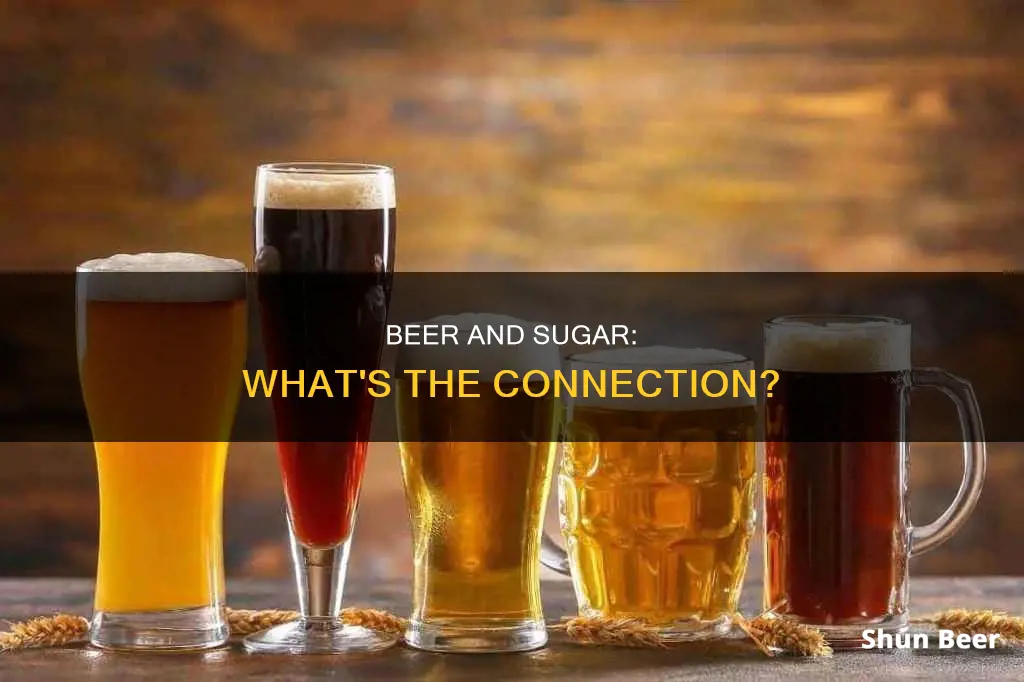
Beer is made from grains, yeast, spices, and water. While sugar is not added to the mix, it is created naturally during the brewing process when the grains are processed and fermented by yeast. The amount of sugar in beer depends on several factors, including the type of beer, the yeast used, and any additional flavours. Generally, non-alcoholic beer has a higher sugar content than light beer, which in turn has more sugar than regular beer. However, the sugar content of beer is typically quite low, and most beers contain little to no sugar.
| Characteristics | Values |
|---|---|
| Does beer contain sugar? | Yes, but it's not added as an ingredient. |
| How does sugar get into beer? | It's created when grains are processed and fermented by yeast. |
| Types of sugar in beer | Maltose, glucose, fructose, and oligosaccharides |
| Beer styles with distinct sugar profiles | Ales, lagers, stouts, IPAs, pilsners, porters, wheat beer, sour beer, amber ale, barleywine, and Belgian ale |
| Sugar content in regular beer | Approximately 10-12.8 grams of carbs, minimal sugar (most are fermented) |
| Sugar content in light beer | Around 3.2-5.9 grams of carbs, virtually no sugar |
| Sugar content in non-alcoholic beer | About 12.2-28.5 grams of carbs, including more unfermented sugars |
| Sugar content in popular beer brands | Varies, with some having up to 5 grams of sugar per serving |
| Impact on blood sugar | Alcohol in beer can lower blood sugar levels, potentially causing hypoglycemia |
What You'll Learn

Beer's sugar content is generally low
The sugar in beer comes from the grains used in the brewing process, such as barley or wheat. During the malting process, the grains are soaked, germinated, and dried, which converts starches into fermentable sugars, mainly maltose. The malted grains are then mashed or soaked in hot water to create a sweet liquid called wort. The wort is then boiled, and hops or other spices are added for flavour and bitterness.
After boiling, the wort is cooled and yeast is added during the fermentation process. The yeast ferments the sugars in the wort, converting them into alcohol and carbon dioxide. This fermentation process significantly reduces the sugar content in the beer.
The final sugar content in beer depends on several factors, including the type of yeast used, the brewing temperature, and any additional ingredients or flavours added, such as honey or corn syrup. Different styles of beer, including ales, lagers, and stouts, will have different sugar profiles due to these variations in the brewing process.
While beer generally has a low sugar content, it does contain carbohydrates, which can affect blood sugar levels. Regular beers tend to have higher carbohydrate content compared to light beers, and non-alcoholic beers typically have the highest sugar content as the sugars are not converted into alcohol.
Overall, while beer does contain some sugar, the amount is usually low, and it is not added as an ingredient but rather is a byproduct of the fermentation process.
Beer's Sugar Impact: What Happens in the Body?
You may want to see also

Sugar in beer is created by beer gravity
Beer gravity refers to the density of the wort relative to water at various stages of fermentation, and it’s mostly determined by sugar content. The density of a wort is largely dependent on the sugar content of the wort. During alcohol fermentation, yeast converts sugars into carbon dioxide and alcohol.
Beer's sugar content primarily derives from the fermentation process, where yeast converts fermentable sugars into alcohol and carbon dioxide, leaving behind varying levels of residual sugars. Beer gravity measures the density of the wort before and after fermentation. It’s all about the sugar:
High gravity beers
These beers start with a wort that’s rich in sugars. The yeast has a feast, but even after converting a lot of it, the result is a beer that’s both higher in alcohol and often sweeter in taste. Think of those bold, boozy stouts that warm you up in winter. High gravity beers typically have more residual sugars and stronger flavours.
Low gravity beers
On the lighter side, these brews begin with less sugary wort, leading to a beer that’s lower in both alcohol content and residual sweetness. Perfect for those sunny days when you want something refreshing without the buzz.
How to increase gravity
If you want to increase the gravity of your homebrew, you can add more fermentable sugar for your yeast to feed on. However, not all yeasts are created equal, and some strains don't have the capacity to produce more alcohol.
Original gravity
Original gravity (OG) is a measure of the fermentable and unfermentable substances in a beer wort before fermentation. Those substances are often the sugars that will be converted to alcohol during the fermentation process. OG gives the brewer an idea of the potential alcohol content in the final product. After fermentation, when OG is mathematically compared to FG (Final Gravity), the exact alcoholic strength can be determined.
Star Beer's Sugar Content: What You Need to Know
You may want to see also

Non-alcoholic beers have the highest sugar content
The reason non-alcoholic beers have a higher sugar concentration is due to the brewing and dealcoholization processes. During fermentation, sugars are converted into alcohol. In non-alcoholic beers, this process is either interrupted before all the sugar is converted or the alcohol is subsequently removed. As a result, more sugar remains in the final product. Dealcoholization can be done through various methods, including reverse osmosis, vacuum distillation, or centrifugation, all of which aim to separate and remove the alcohol while retaining the beer's flavor and, importantly, its sugar content.
Additionally, the absence of alcohol in these beverages means that the sugar is not 'masked' by the bitter notes of alcoholic beers. This can make the sweetness more pronounced and detectable on the palate. It's worth noting that the sugar present in non-alcoholic beers is not always added sugar but can also be natural sugars derived from the grains used in the brewing process, such as barley or wheat.
However, it's important to put this information into context. While non-alcoholic beers may have a higher sugar content, the overall amount of sugar consumed through drinking may still be lower when compared to regular beer due to serving size and drinking occasion. Regular beers often have higher serving sizes, and people tend to consume more in one sitting. Nevertheless, for those watching their sugar intake, it's important to be aware of this difference and make informed choices.
India Pale Ale: Sugar Content and Its Influence
You may want to see also

Light beers have more sugar than regular beers
Beer is generally made from yeast, grains, spices, and water. Sugar is not usually added to the list of ingredients, but it is created naturally when the grains are processed and fermented by yeast. The amount of sugar in beer depends on how it is made. From malting grains to fermenting the brew, each step contributes differently to the final sugar content.
The brewing process can be broken down into five steps: malting, mashing, boiling, fermenting, and maturation. During the malting phase, grains are soaked, germinated, and dried to convert stored starches into fermentable sugars. In the mashing phase, the malted grains are soaked in hot water to release these sugars, creating a sweet liquid called wort. Hops are added for flavor and balance during the boiling phase, and the wort is sterilized. Once the wort is cooled, yeast is introduced in the fermenting phase. The yeast ferments the sugars, producing alcohol and carbon dioxide, thus transforming the wort into beer. Finally, in the maturation phase, the beer develops flavors and carbonation until it is ready to be served.
The sugars in beer come from the grains, not from direct addition, unless specified in particular styles like some craft beers that might use honey or corn syrup for a distinctive flavor. During fermentation, yeast converts these sugars primarily into alcohol and carbon dioxide. While most sugars are converted, the residual sugar that remains contributes to the beer's taste and body.
Light beers are produced by adding glucoamylase to the wort, an enzyme that breaks down residual carbs and transforms them into fermentable sugars. This reduces both the calorie and alcohol content of the beer. Light beers are lower in calories than regular beer because they contain less alcohol, with a range of 3 to 4 percent, while regular beer is anywhere from 5 to 10 percent alcohol.
Light beers are not a major source of sugar, but they do contain a minuscule amount of sugar, less than 1 gram per 12-ounce can. In comparison, regular beer has zero grams of sugar per 12-ounce serving. The fermentation process of the low-sugar extract used to make light beer may explain why light beer has more sugar than regular beer.
Cider Beers: Sugar Content and Health Considerations
You may want to see also

Beer impacts your blood sugar levels
The sugar content in beer comes from the grains used in the brewing process, such as barley or wheat. During the malting process, the grains are soaked, germinated, and dried, which converts starches into fermentable sugars, mainly maltose. While most of these sugars are converted into alcohol during fermentation, some residual sugars remain, contributing to the beer's taste and body.
The immediate effect of drinking beer is an increase in blood sugar levels due to the carbohydrates. However, over a longer period, these levels will decrease as the body processes the alcohol. This can be risky for people with diabetes, as it may lead to hypoglycemia, a condition where blood sugar falls too low. Therefore, it is generally recommended to consume beer with a carb-containing meal to maintain blood sugar balance.
Additionally, alcohol impairs sugar metabolism by inhibiting the body's production and breakdown of stored sugar, which are necessary to maintain blood sugar balance. This can further contribute to the risk of hypoglycemia, especially for individuals taking hypoglycemic medications.
It is worth noting that non-alcoholic beers tend to have higher sugar content than their alcoholic counterparts since the sugars are not converted into alcohol during fermentation. Therefore, drinking non-alcoholic beers may lead to unexpected spikes and subsequent low blood sugar levels, which is significant for those monitoring their blood sugar.
In summary, beer impacts your blood sugar levels by providing carbohydrates and residual sugars that initially raise blood sugar levels, but the alcohol content can lead to a decrease in blood sugar over time. This can be particularly concerning for individuals with diabetes or those taking hypoglycemic medications. As always, moderation is key, and it is advisable to monitor blood sugar levels when consuming beer to understand how it affects your body.
Beer Metabolism: Sugar Conversion Mystery Explained
You may want to see also
Frequently asked questions
Yes, beer contains sugar, but the amount varies depending on the type of beer and the brewing process. The sugar in beer comes from the fermentation of grains, not from direct addition.
The exact amount of sugar in beer can vary, but it is generally very low. Most beers contain little to no sugar, with light beers typically having slightly more sugar than regular beers. Non-alcoholic beers tend to have the highest sugar content.
While the sugar content in beer is generally low, beer is still a source of carbohydrates, which can affect your blood sugar levels. Additionally, beer contains calories, which can contribute to weight gain and increase the risk of obesity and type 2 diabetes. It's important to consume beer in moderation as part of a balanced diet.







